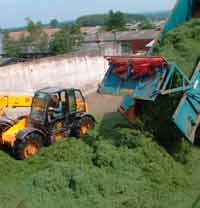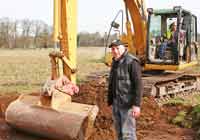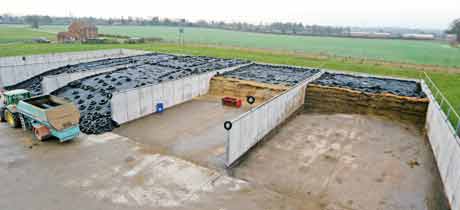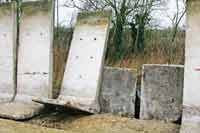Agricultural Buildings Show: looking after your silage clamp

Silage clamps are often a neglected part of the farm’s infrastructure, quietly decaying as the years go by. Their sides begin to crumble and split and the floor, hammered by a daily battering from loaders, becomes a series of potholes and muddy puddles.
Yet year after year these clamps are entrusted with the important task of storing and preserving the farm’s silage. Their ability to do that job well can have a big effect on the feed value produced, which in turn has an important impact on milk yield and quality, not to mention liveweight gain.
So you might think that, with the high cost of growing grass and harvesting it, more effort would be made to ensure that waste is minimised and feed quality maximised.
Which is not to suggest that all farms have poorly maintained clamps – far from it. The problem is that as farms run larger herds, and the wear and tear on clamps becomes greater, clamp capacity is being pushed to the limit. Wall pressure is higher and since more silage is being taken out of these clamps during the winter, the floor has more traffic to contend with.
What does a good clamp look like? • It needs to provide an area large enough and strong enough to hold the required volume of grass, maize or whole-crop so that it can be safely ensiled • When filled, it needs to be airtight so a good plastic sheet of sufficient strength needs to be placed over the top of it • Silage effluent needs to be collected and channelled away so that it doesn’t get into waterways • Rainwater run-off also needs to be channelled away from the clamp • There needs to be enough room for tractors, trailers and loaders to manoeuvre when the clamp is being filled or silage is being removed
Case study
Nottingham University Dairy Centre
Bonington, Leicestershire
 |
|---|
| Dave Fleeman: “In my opinion, concrete panels are better than using metal or concrete upright supports with horizontal sections.” |
The University of Nottingham’s Dairy Centre at Sutton Bonington, Leicestershire is a greenfield project that took place six years ago. The previous site was sold for development.
Until recently, the 170-cow herd was milked through three robotic milking machines, but a recent expansion has seen herd numbers increase to 240 and another robotic milker added to bring the total to four.
Herd manager Nigel Armstrong is a keen advocate of quality silage and understands the contribution it can make to maximising milk production.
“Silage is a valuable commodity,” he says. “It deserves to be made and preserved well and this can only be achieved by ensiling it in clamps that are in good order.”
The initial build saw a five-bay silage clamp being constructed with a capacity for about 3500t. But the extra cow numbers now require an additional bay to be built to bring clamp capacity to 4200t, made up of grass, whole-crop wheat and maize grown on the university farm.
In charge of its construction is Dave Fleeman, who also oversaw the building of the dairy unit, the cows’ cubicle housing and the other five silage bays.
“As with the others, we are going for a bay which measures 27m long and 12m wide with 3.5m high walls,” he says. “The 12m width provides a relatively small working face that reduces secondary fermentation between loads being removed.”

The existing silage clamps at Nottingham University’s Dairy Farm. Note the fall from centre line to sides and from back to front
Site preparation will begin with the removal of the topsoil and, on this occasion, the lowering of the ground level by a couple of metres to match that of the other bays.
Then 150mm of compressed hardcore will be spread across the site and the pre-cast 3.5m high, 1.5m wide concrete wall panels put in place.
“In my opinion, concrete panels are better than using metal or concrete upright supports with horizontal sections,” he says. “The loading on side walls can be very uneven during the loading and compacting process and this can result in the uprights twisting and causing stress fractures in the horizontal sections.”
With the panels in place, the concrete floor is then laid. To provide the correct drainage, a 300mm fall is created from back to front as well as a 400mm fall from the centre line to the clamp’s sides.
“Care should be taken to use the right type of concrete,” says Mr Fleeman. “The resistance of concrete to acid attack by silage effluent depends on a high cement content and the least amount of water to produce a stiff but workable mix.”
He adds that concrete needs to be properly compacted and left to cure for at least 28 days – driving vehicles on concrete before it is cured is the chief cause of concrete failure.
 |
|---|
| When it all goes wrong… These concrete panels have reached the end of the line |
With the required falls in place, silage effluent flows to the sides and then to the front of the bay where drain channels are in place to take the effluent to a storage tank. Before the clamps are filled a perforated plastic pipe is laid down each side of the bay to help with the transfer of effluent.
To limit the corrosive effects of silage on the concrete, the walls are painted with a resin which helps to provide an element of protection.
“It’s something that really needs to be done every couple of years but rarely is,” he says. “In reality though, there is not a lot that can be done to limit the long-term effects of silage on concrete.”
A guide rail is placed around the top of the concrete wall panels, not as a safety rail but to help tractor drivers working on the clamp know just where the edge of the wall is. They are instructed to keep at least 2ft away from the edge.
The new silage bay will be completed in time for this year’s silage season and will contribute to the now-expanded dairy unit’s silage requirement.
University of Nottingham Farm facts
- 240 cows averaging 9700 litres a cow
- Milking Four robots
- Forage Maize, grass and whole-crop wheat
- Clamp capacity: 4200t
- Target milk production 2.4 m litres a year

